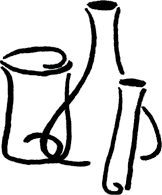
Welcome to Qualitative Analysis!!
This unit is a 6-week extended laboratory experience. Each of you will be given a series of unknown solutions that you will identify on your own using all of our chemical techniques.
Qualitative analysis mostly relies on a series of double displacement reactions to create a separation between what chemicals will form an insoluble precipitate, and those chemicals that stay in solution. In this way, we predictably precipitate chemicals out in order of their reactivities/solubilities.
When we are down to a very limited number of choices, by adding a specific chemical, we can cause a given element to precipitate, proving that it was present in our unknown solution. If you do not get a precipitate at a given step, that particular element (or ion) must not have been present.
Please keep in mind that whether a precipitate forms or not is determined by Ksp and the Ksp expression. If we exceed the limits of Ksp then we get a precipitate. If we don't put enough reagent in (or if our solution is now too dilute from previous steps) no precipitate. Even if the chemical is there! You may get false negatives from over diluting.
The flip-side is true too. If you over-do it by adding too much reagent you can exceed the Ksp for a chemical that will usually stay dissolved. Add an extra drop or two for 'good measure' can cause a chemical to precipitate a step or two early! If your solution is too concentrated, or if you add too much reagent for a given step, you can get a false positive!!
Precipitates: When you have a precipitate your solution will be cloudy.
If your solution is see-through, no precipitate!
Caution: some precipitates are slow-pokes and may need many minutes to cool and form.
Good Luck!!!
Follow the links for hints and suggestions for each of the Unknowns